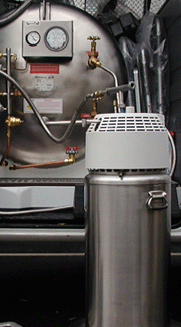Liquid Oxygen Safety
Transporting Liquid Oxygen

A) Truck Body
When transporting liquid oxygen, the cargo compartment needs to have a minimum of two vents in the forward portion of the cargo area and two in the rear portion. Vents need to be as close to the floor line as possible. At a minimum, the total natural ventilation must provide 1 square foot per 300 square feet of compartment ceiling area.B) Bulkhead
The driver’s compartment must be separated from the transfilling and cargo areas to prevent a buildup of oxygen enriched atmosphere from entering the driver’s area. Fixed windows are permitted when transporting liquid oxygen.C) Non-Acceptable Materials For the Cargo Area
No combustible materials such as paneling, plywood, or carpet should be used in the cargo area when transporting liquid oxygen. Diamond plating is advised.D) Outside Ventilation
Any vessels permanently installed in the vehicle must have all safety and vessel vent discharge lines piped outside the vehicle. These vents must be designed so that they are not likely to discharge onto oil or asphalt surfaces or other combustible material or into the vehicle’s exhaust system when transporting liquid oxygen. If they discharge upward, they should have weather protection. Vessels not permanently installed in the vehicle should be suitably restrained during transit to prevent them from moving or tipping over.E) Personnel
Vessels should be filled by trained personnel only.F) Filling in Vehicle
When filling inside the cargo area, all doors should be opened and vent gas should be directed outside. In the interest of liquid oxygen safety, vessels should not be filled when the vehicle is in motion or when engine is running. When vessels are filled outside of vehicle, precautions should be taken to avoid any liquid or gas coming into contact with asphalt or other combustible material.G) Before Starting Engine
Liquid oxygen safety regulations recommend draining all transfer lines and allowing oxygen vapors to disperse before starting engine of vehicle.H) Signs
So others comply with liquid oxygen safety, clearly post signs inside and outside the vehicle prohibiting smoking and open flames.I) Placards
Liquid oxygen safety precautions in the United States state that vehicles and containers must be marked, placarded and labeled in accordance with TITLE 49 of the Code of Federal Regulations and all other federal, state and municipal regulations. Liquid oxygen safety precautions in Canada state that this must comply with the regulations of Transport Canada.Parts & Accessories
For Liquid Oxygen Respiratory Home Care Delivery Systems
Cryofab, Inc. is the only full-service organization for all makes and models of In-Home Liquid Oxygen Respiratory Systems. We are unique in that we are also a cryogenic equipment manufacturer. By combining our expertise in these fields we offer, by far, the greatest product knowledge and experience in the cryogenic aspect of the Homecare industry.


